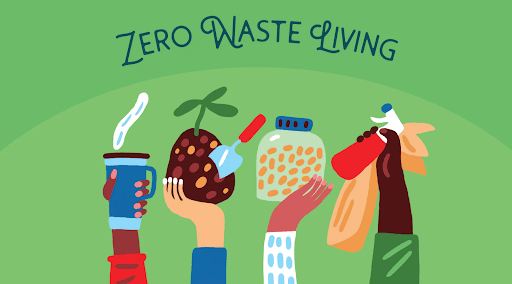
According to the EPA, the average American produces about 5 pounds of solid waste per day. Studies show that food waste is the largest single component in the U.S. landfills, making up 22% of municipal solid waste. The United States discards more food than any other country, wasting approximately 120 billion pounds every year. This means that of those 5 pounds of daily waste per person, about one pound consists of food waste.
Combating Waste: The Zero Waste Movement
Reducing waste is essential, and many are turning to the concept of zero waste. According to the Zero Waste International Alliance, zero waste is defined as: “The conservation of all resources by means of responsible production, consumption, reuse, and recovery of products, packaging, and materials without burning and with no discharges to land, water, or air that threaten the environment or human health.”
To promote waste reduction, the United Nations established International Zero Waste Day in 2022, celebrated annually on March 30. This day advocates for reducing all forms of waste, including food loss, resource extraction, and electronic waste. The 2024 theme highlights zero waste in fashion and textiles, encouraging sustainable practices in the fashion industry.
The fashion industry has been highly altered by the drive of overconsumption and overproduction with clothing production doubling from 2000 to 2015 and yet, 92 million tonnes of textile waste is produced globally. This is the equivalent to a garbage truck full of clothing incinerated or sent to landfills every second.
Waste Management: A Local and Global Issue
All forms of waste management must be addressed at both local and global levels. Local actions drive broader change across the U.S. and beyond. According to a 2015 Nebraska Recycling Study conducted in collaboration with the University of Nebraska-Lincoln:
- Each person in Nebraska generates 2,554.1 pounds of municipal solid waste per year.
- On average, 524.7 pounds of other waste is recycled per year.
- This results in about 8.4 pounds of waste per person daily, including landfill and recycled materials.
While recycling plays a crucial role, expanding recycling programs, especially in rural Nebraska, is essential. The study found Nebraska’s recycling rate to be only 17%, with recycling access largely dependent on population density. People in smaller communities often have fewer recycling options compared to those in larger cities.
The Role of Landfills
Waste reduction, particularly reducing landfill reliance, is critical. While landfills are necessary for managing waste and preventing disease spread, they shouldn’t be the only solution.
Landfills:
- Take up land that could be used for agriculture.
- Pose environmental contamination risks.
- Produce greenhouse gas emissions.
- Lower property values in surrounding areas.
According to the EPA, municipal solid waste landfills are the third-largest source of human-related methane emissions in the U.S. Addressing this issue through waste reduction, improved recycling access, and sustainable practices is essential for a healthier environment and a more sustainable future.
The Waste Management Industry
City administrators are responsible for managing solid waste, which isn’t always a possibility or accessible in every area. Proper waste management protects health, preserves the environment, and enhances city life. However, rapid urban growth and limited funds or infrastructure can lead to poor waste management, harming public health and sustainability.
Waste and recycling regulations in the U.S. are complex, enforced at federal, state, and local levels, but the lack of universal regulations in local and state levels leads to different initiatives regarding waste management. Most regulations revolve around hazardous waste and not waste reduction and recycling.
Federal Regulations (RCRA - Resource Conservation and Recovery Act):
- Governs hazardous waste from creation to disposal.
- Key Requirements:
- Hazardous Waste Identification- Businesses must determine if waste is hazardous.
- Manifest System- Tracks hazardous waste shipments.
- Permitting- Facilities handling hazardous waste need permits.
State Regulations:
- States may expand on federal laws and set stricter standards.
- Example: New York’s E-Waste Law – Makes manufacturers responsible for recycling electronics.
Local Regulations:
- Cities/counties may add further waste management rules.
- Examples:
- Mandatory Recycling – Some areas require recycling of materials like glass and cardboard.
- Landfill Bans – Certain items (e.g., food scraps, yard waste) may be banned from landfills.
Nebraska Waste Management Resources:
- Nebraska Recycling Council: to explore the Nebraska Recycling Guide:
- Municipal Composting Programs: Find composting programs near you using the Nebraska Compost Operators Map:
- Lincoln: EarthFuel, or Uribe Refuse Services
- Firth: Prairieland Dairy
- Gretna/Omaha: Hillside Solutions/Soil Dynamics
- Omaha: Omagro
- Hershey: Bio-Ag Solutions
- Grand Island: Smart Soil, LLC
- Humphrey: Midwest Soilogix
- Local Waste Reduction Policies:
- Find your city or county’s waste reduction policies on their website.
- Example: City of Lincoln Solid Waste Management
- Nebraska Glass Recycling Locations:
- Glass recycling is available in the following communities: Columbus, Geneva, Lincoln, Omaha, Neligh, Valentine, Fremont, Wayne, Kearney, Benkleman, Hershey, Alliance, Dunning, Thedford, Ogallala, Ponca, Ravenna, Stuart, Kimball, and Tekamah
- Household Hazardous Waste Collection Facilities in Nebraska
- Collection facilities are located in: Douglas/Sarpy Counties, Grand Island, Holdredge, Kearney, Lancaster County, Norfolk & Lower Elkhorn NRD area, North Platte, and McCook
- Electronic Recycling
- Electronic waste is not regulated by the state as hazardous waste.
- Find e-waste recycling near you through your Natural Resource District’s website or Keep Nebraska Beautiful for city/county-specific programs.
- Hard to Recycle Plastics: Hefty ReNew
- Recycling hard-to-recycle plastics is possible with the Hefty ReNew bag, available at most grocery stores in and around Lincoln and Omaha.
- Learn more: Hefty Renew- Nebraska
How You Can Make a Difference:
- Consume less: Use what you have first. When purchasing new items, choose sustainable options when possible.
- Manage Waste Properly: ensure items are recycled or reused when possible. Donate clothing and household items, freeze food for later use, compost organic waste, and avoid unnecessary landfill disposal.
- Reduce Food Waste: Plan grocery shopping wisely, use lists, meal prep, and compost organic waste.
- Reduce Packaging Waste – Avoid single-use plastics, excessive food packaging, plastic bags, and unnecessary wrapping materials.
- Shop Locally & Sustainably – Farmers' markets and local businesses are a great place to start.
- Shop Waste-Free – Use reusable shopping and produce bags. Buy in bulk using refillable containers from select grocery stores like Hy-Vee, and waste-free cosmetic products found at Exist Green in Omaha.
- Shop Secondhand – Choose thrift stores, vintage shops, or online platforms like Depop and Facebook Marketplace for clothing, household goods, and furniture.
On this International Day of Zero Waste, I encourage you to be more mindful of the waste you produce. The most effective way to reduce waste is to consume less—though it may seem challenging at first, small, conscious choices can make a big difference. Whether purchasing or disposing of items, strive to do so sustainably to lessen your environmental impact. Resource conservation is key to preserving the good life in Nebraska.
Zero Waste Challenge: Waste nothing today!
For resources and guidance, check out the Nebraska Recycling Council Municipal Waste Reduction Toolkit - a great place to start your journey toward a more sustainable future.
If you want to learn more about waste management attend our free event “Our Perception of Waste” April 29th from 6-7 PM with Shay Flowerday the Environmental Health Educator of Solid Waste Management in Lincoln.

